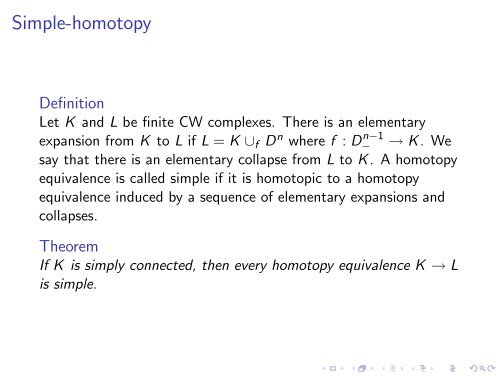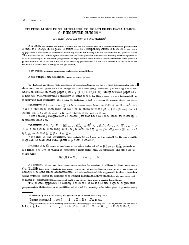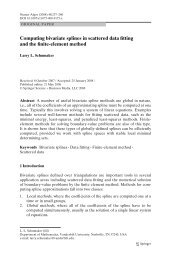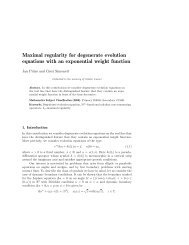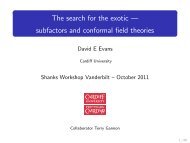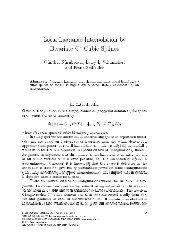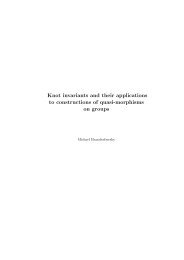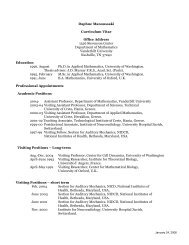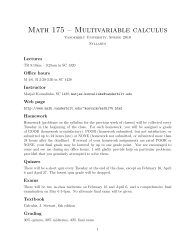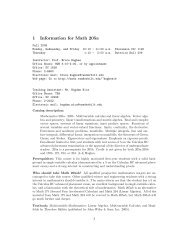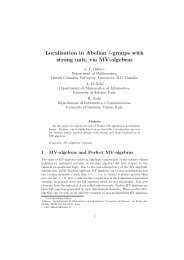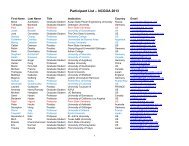Simple-homotopy
Simple-homotopy
Simple-homotopy
Create successful ePaper yourself
Turn your PDF publications into a flip-book with our unique Google optimized e-Paper software.
<strong>Simple</strong>-<strong>homotopy</strong><br />
Definition<br />
Let K and L be finite CW complexes. There is an elementary<br />
expansion from K to L if L = K ∪f Dn where f : D n−1<br />
− → K. We<br />
say that there is an elementary collapse from L to K. A <strong>homotopy</strong><br />
equivalence is called simple if it is homotopic to a <strong>homotopy</strong><br />
equivalence induced by a sequence of elementary expansions and<br />
collapses.<br />
Theorem<br />
If K is simply connected, then every <strong>homotopy</strong> equivalence K → L<br />
is simple.
<strong>Simple</strong>-<strong>homotopy</strong><br />
Example<br />
There are finite complexes with π1 = Z5 that are <strong>homotopy</strong><br />
equivalent but not simple-<strong>homotopy</strong> equivalent.<br />
K is obtained by attaching D 2 to S 1 using a map of degree 5. L is<br />
obtained from K by wedging with S 2 and then attaching D 3<br />
according to the prescription 1 − t + t 3 . 1<br />
In general, if K and L have fundamental group π and f : K → L is<br />
a <strong>homotopy</strong> equivalence, f is simple if and only if a torsion, τ(f ) in<br />
the Whitehead group Wh(π) of π is trivial. Wh(π) measures<br />
whether an invertible matrix with entries in the integral group ring<br />
Zπ can be row and column reduced to a matrix with ± group<br />
elements along the diagonal.<br />
1 (1 − t + t 2 )(t + t 2 − t 4 ) = 1
Hauptvermutung<br />
Question: If K and L are homeomorphic simplicial complexes,<br />
must K and L be piecewise-linear(ly?) homeomorphic?<br />
Originally, this was thought of as an approach to proving the<br />
topological invariance of simplicial homology. Of course, the<br />
introduction of the notion of <strong>homotopy</strong> equivalence gave a much<br />
easier proof of a much stronger theorem.<br />
Theorem (Milnor)<br />
There exist finite simplicial complexes K and L that are<br />
homeomorphic but that are not PL homeomorphic.
Topological invariance of torsion<br />
Theorem (Chapman)<br />
If f : K → L is a homeomorphism between simplicial complexes,<br />
then τ(f ) = 0.<br />
Chapman’s proof was modeled on Kirby-Siebenmann’s work on the<br />
Hauptvermutung for PL manifolds, but in the setting of Hilbert<br />
cube manifolds.
Topological invariance of torsion<br />
Definition<br />
We call a <strong>homotopy</strong> equivalence f : K → L between simplicial<br />
complexes an ɛ-equivalence if there exist a <strong>homotopy</strong> equivalence<br />
g : L → K and homotopies ht : f ◦ g ∼ = id and kt : g ◦ f ∼ = id so<br />
that diam{ht(x)|0 ≤ t ≤ 1} < ɛ for each x ∈ L and<br />
diam{f (kt(y))|0 ≤ t ≤ 1} < ɛ for each y ∈ K.<br />
Theorem (F.)<br />
Given L, there is an ɛ > 0 so that if f : K → L is an ɛ-equivalence,<br />
then τ(f ) = 0.<br />
The first proof of this showed that K × Q and L × Q were<br />
homeomorphic, Q being the Hilbert cube, whence the result<br />
followed from Chapman. However, this point of view soon led to<br />
more direct proofs of Chapman’s theorem.
Topological manifolds, n ≥ 5<br />
Theorem (Chapman-F.)<br />
If M n is a closed connected topological manifold, n ≥ 5, then given<br />
ɛ > 0, there is a δ > 0 so that if f : N → M is an δ-equivalence, N<br />
closed, then f is ɛ-homotopic to a homeomorphism.<br />
Due to the efforts of Freedman-Quinn, Perlman, and others, this<br />
result is now known in all dimensions.<br />
Theorem (F)<br />
If M n is a closed connected topological manifold, n ≥ 5, then there<br />
is an ɛ > 0 so that if f : M → N is a map to a connected manifold<br />
of the same dimension such that diam f −1 (x) < ɛ for each x ∈ N,<br />
then f is homotopic to a homeomorphism.
Grove-Petersen-Wu<br />
Question: Do such <strong>homotopy</strong> equivalences occur naturally?<br />
(Yes, in geometric topology, but I’ll give an application to<br />
differential geometry.)<br />
Theorem (Grove-Petersen-Wu)<br />
The collection of closed Riemannian n-manifolds, n ≥ 5, with<br />
diameter < D, volume > v, and sectional curvature > κ contains<br />
only finitely many homeomorphism (and therefore diffeomorphism)<br />
types.<br />
As above, this result is now known for homeomorphisms in all<br />
dimensions. Some of Perlman’s work generalizes<br />
Grove-Petersen-Wu. This example is included to give a general<br />
idea of what applications might look like.<br />
Definition<br />
A monotone function ρ : [0, R) → [0, ∞) is a contractibility<br />
function for a space X if Bt(x) contracts to a point in B ρ(t)(x) for
Theorem (Grove-Petersen)<br />
There is a function ρ : [0, R) → [0, ∞) which is a contractibility<br />
function for every closed Riemannian n-manifold, n ≥ 5, with<br />
diameter < D, volume > v, and sectional curvature > κ.<br />
This collection of Riemannian manifolds is precompact in<br />
Gromov-Hausdorff space. It is easy to see that manifolds with<br />
contractibility function ρ that are close enough together must be<br />
epsilon <strong>homotopy</strong> equivalent. Therefore, if limit points of the<br />
collection are manifolds, we’re done. An argument involving<br />
crossing with a two-torus and peeling the factors off again removes<br />
this last hurdle.
Theorem (Dranishnikov-F. flexibility)<br />
There exist Riemannian manifolds Mt and Nt, 0 ≤ t < 1 and a<br />
function ρ : [0, R) → [0, ∞) which is a contractibility function for<br />
each Mt and Nt, so that limt→1 Mt = limt→1 Nt with Mt’s<br />
homeomorphic to each other, Nt’s homeomorphic to each other,<br />
but Mt’s not homeomorphic to Nt’s. These manifolds do have the<br />
same simple-<strong>homotopy</strong> types and the same rational Pontrjagin<br />
classes.<br />
Theorem (Dranishnikov-F. rigidity)<br />
If Mt is two-connected and the homology of Mt contains no odd<br />
torsion, then the phenomenon above can’t happen.<br />
The difference between this and the situation that Grove-Petersen<br />
encountered is that the common limit of the Mt’s and Nt’s can be<br />
infinite-dimensional and in this case the homeomorphism type can<br />
vary, but only by finitely many homeomorphism types.
Theorem (Dranishnikov-F.)<br />
If C is a precompact collection of Riemannian n-manifolds, n = 3,<br />
such that there is a contractibility function ρ : [0, R) → [0, ∞)<br />
which is a contractibility function for each M ∈ C, then C contains<br />
only finitely many homeomorphism types.<br />
Actually, this theorem appears earlier in a paper of mine in the<br />
Duke Journal. The argument in the paper with Dranishnikov is<br />
different and more illuminating.


